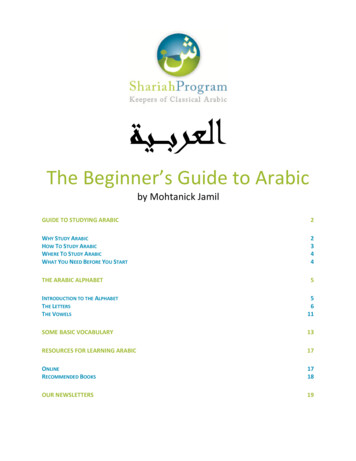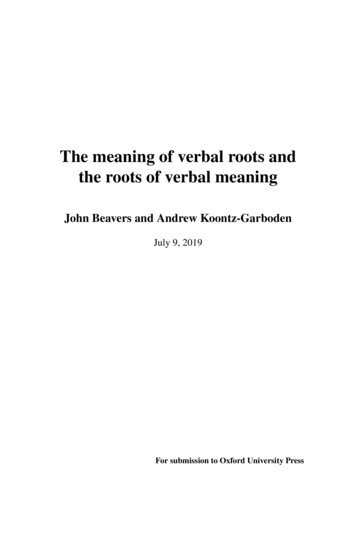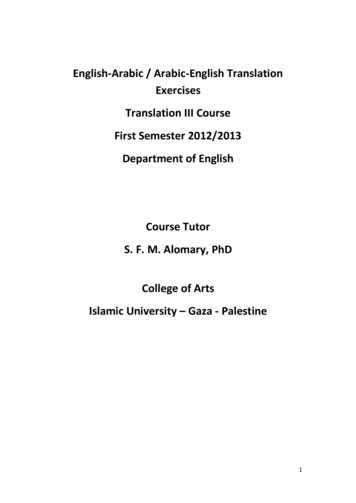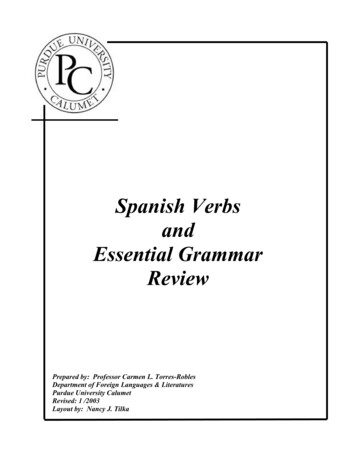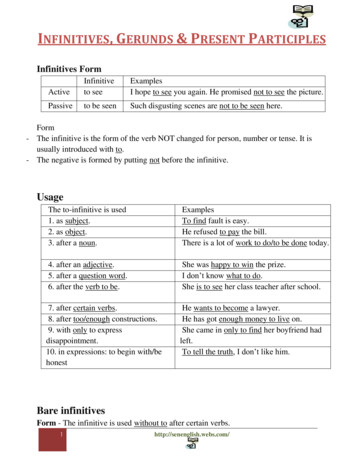
Transcription
Verbs&Essentialsof GrammarSecond EditionJane Wightwick, Mahmoud GaatarNew York Chicago San Francisco Lisbon London Madrid Mexico CityMilan New Delhi San Juan Seoul Singapore Sydney Toronto
Copyright 2008 by The McGraw-Hill Companies, Inc. All rights reserved. Manufactured in the UnitedStates of America. Except as permitted under the United States Copyright Act of 1976, no part of thispublication may be reproduced or distributed in any form or by any means, or stored in a database or retrievalsystem, without the prior written permission of the publisher.0-07-159603-8The material in this eBook also appears in the print version of this title: 0-07-149805-2.All trademarks are trademarks of their respective owners. Rather than put a trademark symbol after everyoccurrence of a trademarked name, we use names in an editorial fashion only, and to the benefit of thetrademark owner, with no intention of infringement of the trademark. Where such designations appear in thisbook, they have been printed with initial caps.McGraw-Hill eBooks are available at special quantity discounts to use as premiums and sales promotions, orfor use in corporate training programs. For more information, please contact George Hoare, Special Sales, atgeorge hoare@mcgraw-hill.com or (212) 904-4069.TERMS OF USEThis is a copyrighted work and The McGraw-Hill Companies, Inc. (“McGraw-Hill”) and its licensors reserveall rights in and to the work. Use of this work is subject to these terms. Except as permitted under theCopyright Act of 1976 and the right to store and retrieve one copy of the work, you may not decompile,disassemble, reverse engineer, reproduce, modify, create derivative works based upon, transmit, distribute,disseminate, sell, publish or sublicense the work or any part of it without McGraw-Hill’s prior consent. Youmay use the work for your own noncommercial and personal use; any other use of the work is strictlyprohibited. Your right to use the work may be terminated if you fail to comply with these terms.THE WORK IS PROVIDED “AS IS.” McGRAW-HILL AND ITS LICENSORS MAKE NOGUARANTEES OR WARRANTIES AS TO THE ACCURACY, ADEQUACY OR COMPLETENESS OFOR RESULTS TO BE OBTAINED FROM USING THE WORK, INCLUDING ANY INFORMATIONTHAT CAN BE ACCESSED THROUGH THE WORK VIA HYPERLINK OR OTHERWISE, ANDEXPRESSLY DISCLAIM ANY WARRANTY, EXPRESS OR IMPLIED, INCLUDING BUT NOTLIMITED TO IMPLIED WARRANTIES OF MERCHANTABILITY OR FITNESS FOR A PARTICULARPURPOSE. McGraw-Hill and its licensors do not warrant or guarantee that the functions contained in thework will meet your requirements or that its operation will be uninterrupted or error free. NeitherMcGraw-Hill nor its licensors shall be liable to you or anyone else for any inaccuracy, error or omission,regardless of cause, in the work or for any damages resulting therefrom. McGraw-Hill has no responsibilityfor the content of any information accessed through the work. Under no circumstances shall McGraw-Hilland/or its licensors be liable for any indirect, incidental, special, punitive, consequential or similar damagesthat result from the use of or inability to use the work, even if any of them has been advised of the possibility of such damages. This limitation of liability shall apply to any claim or cause whatsoever whether suchclaim or cause arises in contract, tort or otherwise.DOI: 10.1036/0071498052
For more information about this title, click hereContentsIntroduction1. The Arabic root system56Part One: Arabic Verbs2. Regular verbs: The basic tenses3. Irregular verbs: Introduction4. Irregular verbs: Verbs with waaw or yaa’as a root letter5. Irregular verbs: Doubled verbs6. Irregular verbs: Verbs with hamza7. Derived forms of verbs: Introduction8. Derived forms II–IV9. Derived forms V–VI10. Derived forms VII–X11. Essentials of making sentences with verbs12. Verbs in the subjunctive13. Verbs in the jussive (incl. the imperative)14. Making verbs negative15. Making verbs passive16. Verbal nouns and other verbal constructions17. Verbs in the dual18. Verbs with four root letters (quadriliterals)19. Some unusual common verbs131920303338404754626569798287959799
Part Two: Arabic Essentials of Grammar20. The article and personal pronouns21. Genders22. Sentences without verbs23. Describing things24. Describing position (prepositions of place)25. Plurals26. Describing possession27. Questions and relative clauses28. The dual105107109111115116119122123Appendixes(i) Arabic alphabet and pronunciation(ii) Grammatical case endings(iii)Numbers124125126Verb Index: 400 Arabic verbs for easy referenceArabic–EnglishEnglish–Arabic127128144
IntroductionThis book is intended for beginning and intermediate learners ofArabic. You could be studying in a group or by yourself. Either way,you should find this book an essential and accessible introduction toArabic verbs and grammar and a helpful on-going reference.We are assuming a basic knowledge of the Arabic script as it is notpossible to teach this skill within the parameters of this guide.However, to help you we have also included transliterationthroughout, using a simplified system (see Appendix (i), page 124).Arabic Verbs and the Essentials of Grammar aims to make Arabicgrammar more understandable by presenting it in an accessiblestyle. This guide covers most of what you will need to know aboutArabic verbs during your study of modern Arabic, and also providesa useful summary of the main grammar points.This is a study aid rather than a course. However, there is progressionin the two main parts of the book, or you can simply dip in to brushup on a particular area.Verb IndexThis second edition also includes a comprehensive Verb Indexlisting 400 high-frequency Arabic Verbs (including all those in thisbook). The index will enable you to look up individual verbs inArabic or English alphabetical order and find out theirpronunciation, root letters and type. You will then be able toreference them to the relevant sections in this book. Not only this,you will also gain a better insight into how the Arabic verbalsystem works in general, and so be able to use other advanceddictionaries and references more effectively.We hope you find this book a useful tool in your study of Arabic.Copyright 2008 by The McGraw-Hill Companies, Inc. Click here for terms of use.
1The Arabic rootsystemThe key to understanding how Arabic grammar works is in its systemof roots. Once you understand how roots work, you can start to identifywhich are the root letters of a word and understand the patterns theyproduce. You will then be able to form the different structuresfollowing the patterns and use your knowledge to pronounce wordscorrectly and to guess at the meaning of vocabulary.We can begin by looking at some English cessityAs a speaker of English, you can see that these words are connected inmeaning. You see the combination of letters “necess” and you knowthat this word is connected with the meaning of “needing.” You canrecognize the extra letters on the beginning and end of the word asadditional to the meaning: un- meaning “not”; the ending -ity showingthat the word is a noun; -ly that it is an adverb, etc.Now look at these Arabic words:ÖàcÜÉàcÖàµeÖàµjÖJÉc(kataba) he wrote(kitaab) book(maktab) office(yaktub) he writes(kaatib) writerCopyright 2008 by The McGraw-Hill Companies, Inc. Click here for terms of use.
The Arabic root system7Can you spot the three Arabic letters that appear in each of the wordson the previous page? You should be able to see that these lettersappear in all the words:1. (kaaf)2.ä(taa’)3.Ü(baa’)(Look at Appendix (i) if you need to remind yourself of the Arabicalphabet.)Notice that the letters appear in the same order in all of the words: thekaaf comes first, then the taa’, and finally the baa’. These three letters,in this order, are the root.Ö à croot letter 3root letter 2root letter 1Look back at the previous page again and see if you can spot thesethree root letters in all the words. Notice that sometimes there are otherletters as well as the root letters, but the root letters will always appearin the same sequence.The root sequence we have looked at (kaaf, taa’, baa’) is connectedwith the meaning of “writing.” Whenever you see a word with thisroot, it probably has something to do with writing. The root lettersmushroom into many different possible words. For example, when theroot letters are put into a particular pattern with the letter miim (Ω) at thefront, the meaning becomes “a place of writing,” or “a desk/an office”:Öàµe (maktab)The vast majority of Arabic words contain three root letters, as in theexample above. Much of Arabic grammar is concerned withmanipulating the three root letters into different patterns. If you lookback at the English words on the first page of this chapter, you will
8The Arabic root systemsee that most of the changes take place at the beginning and the end ofthe word, leaving the core untouched. Arabic, on the other hand, addsletters, or combinations of letters, between the root letters, as well ason the beginning and end. Look at the word for “book” (kitaab):additional letter (’alif)ÖÉà croot letter 3root letter 2root letter 1As a symbol to represent the three root letters of any word, Arabicgrammar uses the letters π a (f/ /l). So the word for “office” – Önàµr en(maktab) – is the πn Ør en (maf al) pattern; i.e., the root letters have ma ( ne)before them, a sukuun ( r ) over the first root letter and a fatHa ( n ) overthe second root letter. In the same way, the word áHÉàpc (kitaaba) wouldbe the ádÉ pa (fi aala) pattern, Öoàco (kutub) would be the πo ao (fu ul)pattern, etc. In the first chapters of the book, we have tried to also useother common words to illustrate the patterns. However, later we haveintroduced more examples using π a, since this is the conventionunderstood most widely by both native speakers and Arabists.You will find the root system very helpful once you have understoodthe concept and been introduced to some of the more common patterns.Native Arabic speakers have an instinctive understanding of how theirlanguage works, but as a learner you will need to approach it moremethodically. Soon you will begin to see the pattern and the shape ofwords, and the structure of the language will start to become apparent.Using a dictionaryIt is worth adding a note about how to use an Arabic dictionary. It ispossible to put Arabic in strict alphabetical order as we do in English,and this is becoming more common in the age of computerized
The Arabic root system9alphabetization (see page 124 for the order of the Arabic letters).However, the most widely used dictionary for learners (A Dictionary ofModern Written Arabic, Hans Wehr) uses a system based on the rootletters of the word. This means all words with the same root letters aregrouped together. You will need to try and figure out the root letters ofa word before you can look it up in the dictionary. Here is an example,showing the root Öàc (katab):basic rootother words fromthe same root
10The Arabic root systemThe Arabic–English verb index on pages 128–143 of this book isarranged in strict alphabetical order. From this you can identify the rootletters for a particular verb, enabling you to look it up in Wehr’sdictionary, and other similarly arranged references.
Part One:Arabic VerbsCopyright 2008 by The McGraw-Hill Companies, Inc. Click here for terms of use.
This page intentionally left blank
2Regular verbs:The basic tensesArabic is relatively straightforward when it comes to tenses. Somelanguages have many tenses and are very specific about the time of anaction and whether or not the action has been completed. Arabicgrammar is vague about time and there are only two basic tenses:p The past (or perfect) » VÉŸG The present (or imperfect) pQÉ †nŸGThe PastIn a simple regular verb, the basic past tense will look like this:Ön àn cnnÜôp Tnπn ªn Mn(kataba): (he) wrote(shariba): (he) drank(Hamala): (he) carriedThe three root letters are all followed by a vowel. In most cases this isall fatHas (kataba/Hamala), but sometimes the second vowel is aKaSra (shariba). (In rare cases, the second vowel is a Damma (u), butyou can ignore these verbs since you are not likely to see or use them.)If we take off the final vowel, this nƒog (“he”/“it”) part of the verb (thirdperson masculine singular) becomes the base, or stem of the past tense.Different endings can be added to this past stem depending on who iscarrying out the action (the subject of the verb). So, nÖnànc (kataba) is “hewrote” and Önànc (katab) is the past stem. If we add the ending äo (tu) tothe stem, it becomes oârÑnànc (katabtu) – “I wrote”; if we add Énæ (naa), itbecomes ÉærÑnànc (katabnaa) – “we wrote,” etc. Here is a table showing allthe endings for the past tense:Copyright 2008 by The McGraw-Hill Companies, Inc. Click here for terms of use.
14Arabic VerbsEndingExamplesingularIoä (tu)oârÑnàc(katabtu)ân rfnCGyou (masc.*)än (ta)(katabta)pârfnCGyou (fem.*)pä (ti)ân Ñr àn cnpâÑr àn cnƒn go»n gphe/it n (a)Ön àn cn(kataba)she/itâr n (at)âr Ñn àn cn(katabat)ÉfCG(katabti)pluraløo ër nfweÉnf (naa)Éæn Ñr àn cn(katabnaa)rºoàrfnCGyou (masc. pl)rºoJ (tum)rºoàrÑnàcn(katabtum)øs ào fnCGyou (fem. pl)øs oJ (tunna)øs ào Ñr àn cn(katabtunna)ºgothey (masc.)øs gothey (fem.)**Gƒ o (uu)GƒÑo àn cn(katabuu)n¿ (na)øn Ñr àn cn(katabna)* For an explanation of masculine and feminine genders, see page 107.** An extra ’alif (G) is written after the waaw (ƒ) but is silent.Note that you will not meet or need the feminine plurals as often as themasculine plurals. This is because you only use the feminine plural ifall the people in a group are female. If the group is mixed male andfemale, the masculine is used. Therefore, this form is the mostimportant to learn and become familiar with in the first place. Thereare also different endings for two people (the dual). To make it easierto absorb the basics first, an explanation of the dual and its associatedverb endings has been separated. Refer to Chapters 17 and 28 for anexplanation of the dual if you need it.
Regular verbs: the basic tenses15You do not have to use the personal pronouns (he, she, etc.) before theverb as you do in English. If you see an Arabic sentence like this:.É¡n eu ’oC ádÉ SpQ âÑn àn cn(She) wrote a letter to her mother.you can tell it is “she” because of the ending of the verb (katabat). Thesentence could be more specific and say exactly who wrote the letter(the subject of the verb). Then you would see:.É¡n eu oC’ ádÉ SpQ áªWÉa âÑn àn cnFatma wrote a letter to her mother.Notice that in written Arabic the subject (Fatma) usually comes afterthe verb (wrote). More explanation of word order can be found inChapter 11.The PresentThe present is used for an action (or state) which is still going on(unfinished). Whereas the past is formed by adding endings to a stem,the present adds letters on the beginning and end of a different presentstem to show the subject of the verb. Look first at the present verbbelow. These letters on the beginning and end are underlined in thethird column. Can you identify the stem that appears throughout?singularÉfnCGIÖo ào cr nCG’aktub(u*)ân rfnCGyou (masc.)Öo ào rµnJtaktub(u*)pârfnCGyou (fem.)nÚpÑoàrµnJtaktubiinaƒn go»n pghe/itÖo ào rµjnyaktub(u*)she/itÖo ào rµnJtaktub(u*)* The final ending (u) on some of the verbs above has been put inparentheses because it is not usually pronounced.
16Arabic Verbspluraløo ër nfwerºoàrfnCGyou (masc. pl)n¿ƒoÑoàrµnJøs ào fnCGyou (fem. pl)øn Ñr ào rµnJºgothey (masc.)n¿ƒÑo ào rµjnøs gothey (fem.)øn Ñr ào rµjnnaktub(u)Öo ào rµnftaktubuunataktubnayaktubuunayaktubnaIf you look at the table, you can see that the present stem — whichappears in all the examples — is Öoàrµ (ktub): the three root letters k/t/b,with no vowel after the first letter and a Damma ( o ) after the second.The different letters added on the beginning and end (prefixes andsuffixes) are arranged around this present stem to show the subject ofthe verb. For example:n¿ƒÑo àro µjn n¿ho Ñàro c jnyaktubuuna(Read this way.) suffix (uuna) stem (ktub) prefix (ya)(they write)We can apply the same principle to another verb:Ún ùp p énr J øpn j ù p Lr nJtajlisiina(you [fem.] sit) suffix (iina) stem (jlis) prefix (ta)
Regular verbs: the basic tenses17The present is used for both continuous and habitual actions or states,where in English we might use a different tense:.á ªor G Ωƒr jn IôoµdG ÉØ rWnC’G Ö rn jnThe children play football on Friday(s).! ó rn en ‘ on jpó Un ùp ér jnYour friend is sitting in my chair!As with the past, the vowel on the second root letter varies in thepresent. If the middle vowel on the past is a kasra, then it usuallychanges to a fatHa in the present:shariba Üpn ô Tnyashrab Üôn ûr jn(he drank)(he drinks)However, the majority of verbs have fatHa as the middle vowel of thepast and, for these verbs, there is no rule to follow in the present. Ifyou need to know the vowel, you can look in a dictionary where youwill find the middle vowel written after the entry:root lettersof verbmiddle vowelof presentRemember that in most cases the middle vowel will not affect themeaning of the text or your understanding of it. Most Arabic is writtenwithout vowels and you will probably learn the more common middlevowels over time. Don’t worry too much about this aspect. Nativespeakers will usually understand you as long as the root letters and thepatterns are correct.
18Arabic VerbsThe FutureIf you want to talk about the future in Arabic, you also use the presenttense. Often the word n ƒr Sn (sawfa) or the prefix Sn (sa) are added tothe front of the verb to indicate the future.Gónk Z ôq ür pŸG ën ànr ŸG pEG Ögrn òæn SnWe are going to the Egyptian museum tomorrow. jônÿG ‘ ùpWÉ ÑdGn ìÓnØdG Qn õr jn n ƒr SnThe farmer will plant potatoes in the Fall.Summary of basic tenses There are only two basic tenses in Arabic:the pastthe present The past stem is formed from the three root letters with a fatHaafter the first root and a fatHa (or sometimes a kasra) after thesecond root letter (katab/sharib). Endings are added to the stemto show the subject of the verb. The present stem is formed from the three root letters with avowel after the second (ktub/shrab/jlis). Prefixes, and sometimesalso endings, are added to the stem to show the subject of the verb. The future may be made by adding n ƒr Sn (sawfa) or Sn (sa) tothe present.
3Irregular verbs:introductionIrregular verbs can be defined as verbs that act differently from thebasic patterns in all or some cases. Unfortunately for the learner,Arabic has many irregular verbs (although some are more irregularthan others!) These fall into three categories and include some of themost common verbs: Verbs with waaw (h) or yaa’ ( ) as one of the root letters Verbs with hamza (A) as one of the root letters Doubled verbs, where the second and third letters of the root arethe sameThe first category is the most common, and verbs in this category alsodisplay the most irregularities.To help you remember the irregular verbs, we have chosen commonverbs in each category to illustrate the patterns in which they appear.The verbs you see in the tables and examples in the following chaptersare those you will probably encounter on a regular basis and will needto communicate in Arabic. By studying the way they work and meetingthem frequently in spoken and written Arabic, these verbs should helpto establish the irregular patterns in your mind.The irregular verbs are covered first in the basic tenses (see Chapter 2for a review of these tenses). Later chapters cover the various formsand variations. If you need to access this information immediately, gostraight to the relevant chapter which will show you how each type ofirregular verb behaves in these circumstances. If you want a generaloverview, work your way more systematically through the chapters inthe order they are presented.Copyright 2008 by The McGraw-Hill Companies, Inc. Click here for terms of use.
4Irregular verbs:Verbs with waaw or yaa’as a root letterWaaw (h) and yaa’ ( ) are often called weak letters, and the verbs theycontain called weak verbs. These letters do not have a strong sound,unlike letters such as baa’ (Ü) or kaaf ( ), and often drop out of wordsor become vowel sounds when put into the various patterns.Weak verbs are the largest category of irregular verbs. They can besubdivided into three types depending on which of the root letters isaffected: Verbs with waaw or yaa’ as the first root letter (assimilated verbs) Verbs with waaw or yaa’ as the second root letter (hollow verbs) Verbs with waaw or yaa’ as the third root letter (defective verbs)Waaw or yaa’ as first root letterThis is one of the simplest irregular patterns. Verbs with yaa’ as the first root letter are rare and almost completelyregular. Verbs with waaw as the first root letter are regular in the past(perfect) tense:.èneÉfrônÑdG ‘ áq pY ÉfrónLhnWe found a bug (flaw) in the program.Copyright 2008 by The McGraw-Hill Companies, Inc. Click here for terms of use.
Verbs with waaw or yaa’ as a root letter 21.äÉHÉîpàrf’G ó r Hn ÖpFGô †dGs †«Øîr àpn H áeƒµo G äón Yn hnThe government promised a reduction in taxes after the elections.IôpFÉ dÉH ƒZɵ« T pEG Gƒo Un hnThey arrived in Chicago by airplane.In the present, the first root letter almost always drops outcompletely:p jn (yaSil) he arrives (from the root π Uh)π ün¿hóo péjn (yajiduuna) they find (from the root óLh) †nn J (taDa ) she puts (from the root Vh)Compare this to the regular form of the present Öoàrµnj (yaktub). In theassimilated verb, the first root letter has disappeared altogether fromthe stem, leaving just the second and third root letters (Sil/jid/Da ).The table below shows more fully the present tense for the verbp j/π ün πn Un hn (to arrive):singularIp nCGπo U’aSil(u)ân rfnCGyou (masc.)p Jπo üntaSil(u)pârfnCGyou (fem.)p JÚn p üntaSiliinaƒn go»n pghe/itp njoπ üyaSil(u)she/itp Joπ üntaSil(u)ÉfnCG
22Arabic Verbspluralp fπo ünøo ër nfwenaSil(u)ºr ào rfnCGyou (masc. pl)p Jn¿ƒo üntaSiluunasøoàfnCGyou (fem. pl)taSilnaºgothey (masc.)p Jnør ünp jnn¿ƒo üøs gothey (fem.)p jnøn r üyaSilnayaSiluunaWaaw or yaa’ as second root letterThis group of verbs contains some of the most commonly used verbs inthe Arabic language. They are called hollow verbs because the second(middle) root letter is often replaced by a long or short vowel.Hollow verbs in the pastIn the past tense, all hollow verbs have a long aa sound ( É n ) instead ofthe middle root letter for ƒg (he/it), »g (she/it) and ºg (they):¿n Éncär QGn nRGƒYÉo HnQÉn nW(kaana : “he/it was”) from the root: ¿ƒc(zaarat : “she visited”) from the root: QhR(baa uu : “they sold”) from the root: «H(Taara: “he/it flew”) from the root: ÒWThe other parts of the verb have a short vowel instead of the middleroot letter (see separate chapter for dual verbs). This is usually aDamma if the middle root letter is a waaw, and a kasra if it is a yaa’:âo æor cÉnfQr oRºr ào pr Hpäôr pW(kuntu: “I was”) from the root: ¿ƒc(zurnaa: “we visited”) from the root: QhR(bi tum : “you [pl.] sold”) from the root: «H(Tirti: “you [fem.] flew”) from the root: ÒW
Verbs with waaw or yaa’ as a root letter 23.É †jôk en n¿ÉcHe was ill. ÉÑ Gp n ƒnr a IôpFÉ dG äQÉWnThe airplane flew over the mountains.? Qƒj ƒ«f ‘ rºoµàr«nH ºoà pH rπngHave you sold your house in New York?. ùer GnC ën ànr ŸG ÉnfQr oRWe visited the museum yesterday.This table summarizes the past tense for hollow verbs:Verbs with waaw*(QGR to visit)Verbs with yaa’(QÉW to fly)singularäo ôr Wpnäôr Wp(Tirtu)päôr Wp(Tirti)Qn GRn (zaara)är Qn GRn (zaarat)Qn É nWär Qn É nW(Taara)(Tirnaa)Iäo Qr Ro (zurtu)nârfnCGpârfnCGyou (masc.)än Qr Ro (zurta)päQr Ro (zurti)ƒn go»n pghe/itÉfCGyou (fem.)she/it(Tirta)(Taarat)pluraløo ër nfºr ào rfnCGweÉnfQr Ro (zurnaa)you (masc. pl)ºr oJQr Ro (zurtum)Énfôr Wpºr oJôr Wpøs ào fnCGºgoyou (fem. pl)øs oJQr Ro (zurtunna)øs oJôr Wp(Tirtunna)they (masc.)GhQo GRn (zaaruu)(Taaruu)they (fem.)n¿Qr Ro (zurna)GhQo É nWn¿ôr Wpøs go* See page 24 for exceptions.(Tirtum)(Tirna)
24Arabic VerbsThere are a few hollow verbs that behave in the past like verbs withyaa’ as the middle root letter, but which actually have waaw in themiddle. One of the most common verbs of this type is “to sleep,” fromthe root letters Ωƒf:.É¡eq GoC ôjô Sn ‘ âr eÉfnShe slept in her mother’s bed.ìÉÑn üdGn às Mn âo ªr pfI slept until morning.From the table on page 23, you might have noticed that there is a shortvowel in the middle of hollow verbs when there is a sukuun ( r ) overthe third root letter. This is a general rule for hollow verbs and is worthremembering as it works for all types, tenses, and forms of hollowverbs: Sukuun over third root letter of regular verb short vowel in the middle of irregular hollow verb Vowel over third root letter of regular verb long vowel in the middle of irregular hollow verbHollow verbs in the presentIn the present tense, hollow verbs also follow the rules highlightedabove. Since the present tense usually has a vowel after the third rootletter (even if this is not always pronounced), this means that hollowverbs in this tense are characterized mainly by a long vowel in themiddle. The difference is that, whereas in the past the long vowel in themiddle is always a long aa (kaana), in the present it is a long ii if thesecond root letter is a yaa’ and usually a long uu if the second rootletter is a waaw:Qho õo jn (yazuur[u]: “he visits”) from the root QhRn¿ƒo «pÑnj (yabii uuna: “they sell”) from the root «HVerbs like Ωƒf (see above) are the exception since they have a long aa
Verbs with waaw or yaa’ as a root letter 25in the middle of the present:ΩÉo nænj (yanaam[u]) he sleeps¿n ƒeÉo æn jn (yanaamuuna) they sleepHere is a complete table and some examples showing the threedifferent types of hollow verb in the present. Pay the most attention tolearning the first two types. The third type has been included mainlyfor recognition. Notice that only the less common feminine pluralshave a sukuun over the third root letter and a short vowel in the middle.As in the past, this vowel depends on the middle root letter.singularÉfCGMost verbswith waawoQhoRnCG (’azuur[u])âo õno Jn rfnCG QhpârfnCG øjQhn oõnJQhƒn goo õo jn»n pg oQhoõnJ(tazuur[u])Verbs withyaa’oÒpWnCGÒo p nJ(tazuuriina) nøjÒp nJVerbs likeΩÉæj ,ΩÉf(’aTiir[u])oΩÉnfnCG (’anaam[u])(taTiir[u])ΩÉo ænn J (tanaam[u])(taTiiriina) nÚpeÉnænJ (tanaamiina)(yazuur[u])Òo p jn(yaTiir[u])ΩÉo æn jn (yanaam[u])(tazuur[u])oÒp nJ(taTiir[u])oΩÉnænJ (tanaam[u])Òøo ëo p nfo õno f (nazuur[u])r nf Qhºr ào rfnCG ¿n hQho np Jo õno J (tazuuruuna) ¿n hÒøs ào fnCG n¿Qr õno J (tazurna) n¿ôr p nJ(naTiir[u])ΩÉo ænn f (nanaam[u])pluralºgo ¿n hQho õo jn (yazuuruuna) ¿n hÒo p jnn¿Qr õo jnn¿ôr p jnøs go(yazurna)n ƒeÉ(taTiiruuna) ¿o ænn J (tanaamuuna)(taTirna)øn ªr ænn J(tanamna)n ƒeÉ(yaTiiruuna) ¿o æn jn (yanaamuuna)(yaTirna)øn ªr æn jn(yanamna)
26Arabic Verbsp pFôdG.ô¡r Tn πoq c ÉæÑàrn µen Qhõo jn »q ù«n ÉæfƒHnROur major client visits our office every month.á ªor G QÉés àdo ƒ üo ënr ŸG «pÑnfWe sell the crop to wholesalers.Iô ûYn á«pfÉnãdG áYÉ ùdG Ωƒr jn πoq c ΩÉnfnCGI go to sleep every day at twelve o’clock.Waaw or yaa’ as third root letterThis group of verbs is sometimes called defective verbs. There are threemain types: Verbs with waaw as the last root letter. Verbs with yaa’ as the last root letter and fatHa as the middle vowelin the past Verbs with yaa’ as the last root letter and kasra as the middle vowelin the pastIn the past tense, the first two types are reasonably regular. Only the partsof the verb for ƒg (he/it), »g (she/it) and ºg (they) are irregular:From the root ƒµ T:Énµ Tn (shakaa: “he complained”)ânr µ Tn (shakat: “she complained”)Gƒnr µ Tn (shakaw: “they complained”)From the root » ûe: ûn en (mashaa: “he walked”)âr ûn en (mashat: “she walked”)Gƒr ûn en (mashaw: “they walked”)All of the irregular parts of these two types are pronounced the same.The only difference is the spelling of ɵ T (shakaa) with a final ’alif,
Verbs with waaw or yaa’ as a root letter 27and ûe (mashaa) with a final yaa’ (without the dots). (Look atAppendix (i) if you want to know more details about this final yaa’which is pronounced aa and known as ’alif maqsuura.) The differencesbetween these two types of verbs are more apparent in the regular partsof the past:äo ƒnr µ TÉæn «r ûn enân «r en Qnºor Jƒr Ln Qn(shakawtu : “I complained”) from the root: ƒµ T(mashaynaa : “we walked”) from the root: » ûe(ramayta : “you threw”) from the root:»eQ(rajawtum: “you [pl.] requested/hoped”) from the root: ƒLQMost defective verbs follow one of the two patterns above. However,there are some verbs with yaa’ as the last root letter and kasra as themiddle vowel that follow a different pattern. Two common examplesare the verbs »n ùnp f (nasiya – to forget) and »n p nd (laqiya – to meet).These verbs have a long ii in many parts of the past tense, e.g. oâ«p ùnf(nasiitu) – “I forgot.”The following table summarizes the past tense for all three main typesof defective verbs:defective type 1(ɵ T to complain)defective type 2( ûe to walk)defective type 3(»ù f to forget)singularÉfCG äo ƒnr µ Tnn ƒnr µ TnnârfnCG äpârfnCG päƒnr µ Tn(shakawtu)âo «r ûn en (mashaytu)â«o ùnp f(nasiitu)(shakawta)ân «r ûn en (mashayta)(nasiita)(shakawti)pâ«r ûn en(mashayti)nâ« ùnp fpâ« ùnp fÉnµ Tn(shakaa) ûn en(mashaa)(nasiya)ânr µ Tn(shakat)âr ûn en(mashat)n» ùnp fâr «n ùnp fƒn go»n pg(nasiiti)(nasiyat)
28Arabic Verbsdefective type 1(ɵ T to complain)defective type 2( ûe to walk)defective type 3(»ù f to forget)pluraløo ër nf Énfƒnr µ Tn (shakawnaa) nÉæ«r ûn en (mashaynaa)rºoàrfnCG ºor Jƒnr µ Tn (shakawtum) ºr ào «r ûn en (mashaytum)øs ào fCGn øos Jƒnr µ Tn (shakawtunna) øs ào «r û
The Arabic root system 9 alphabetization (see page 124 for the order of the Arabic letters). However, the most widely used dictionary for learners (A Dictionary of Modern Written Arabic, Hans Wehr) uses a system based on the root letters of the word. This means a
